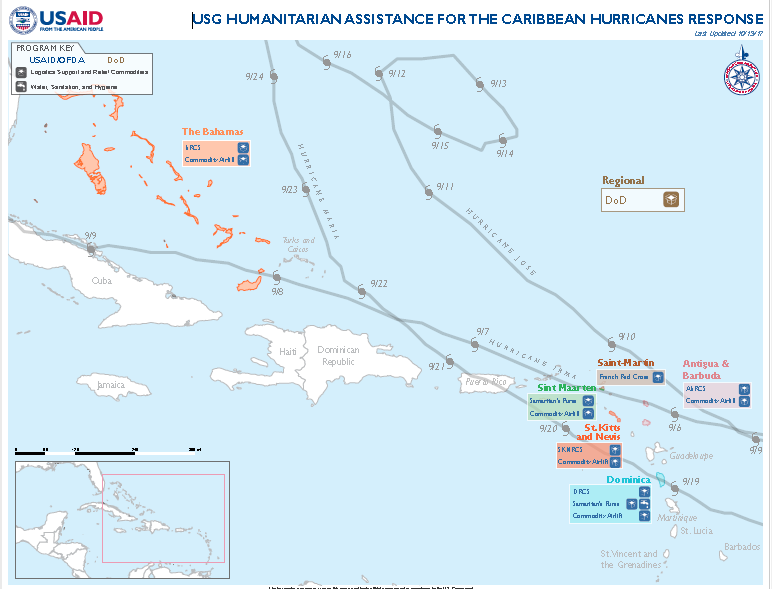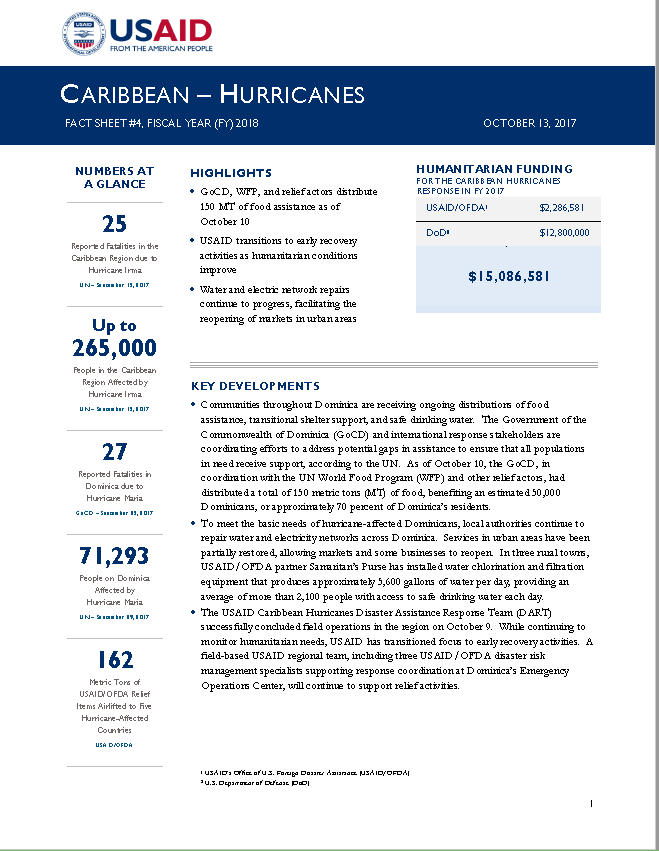Speeches Shim
Octber 13, 2017
Highlights
- GoCD, WFP, and relief actors distribute 150 MT of food assistance as of October 10.
- USAID transitions to early recovery activities as humanitarian conditions improve.
- Water and electric network repairs continue to progress, facilitating the reopening of markets in urban areas.
Key Developments
Caribbean Hurricanes - Map #4 FY18 ![]() (pdf - 279k)
(pdf - 279k)
Numbers At A Glance
25
Up to 265,000
27
71,293
162
Humanitarian Funding
For the Caribbean Hurricanes Response in FY 2017
| USAID/OFDA | $2,286,581 |
| DoD | $12,800,000 |
| Total | $15,086,581 |
Caribbean Hurricanes - Fact Sheet #4 FY18 ![]() (pdf - 229k)
(pdf - 229k)
Communities throughout Dominica are receiving ongoing distributions of food assistance, transitional shelter support, and safe drinking water. The Government of the Commonwealth of Dominica (GoCD) and international response stakeholders are coordinating efforts to address potential gaps in assistance to ensure that all populations in need receive support, according to the UN. As of October 10, the GoCD, in coordination with the UN World Food Program (WFP) and other relief actors, had distributed a total of 150 metric tons (MT) of food, benefiting an estimated 50,000 Dominicans, or approximately 70 percent of Dominica’s residents.
To meet the basic needs of hurricane-affected Dominicans, local authorities continue to repair water and electricity networks across Dominica. Services in urban areas have been partially restored, allowing markets and some businesses to reopen. In three rural towns, USAID/OFDA partner Samaritan’s Purse has installed water chlorination and filtration equipment that produces approximately 5,600 gallons of water per day, providing an average of more than 2,100 people with access to safe drinking water each day.
The USAID Caribbean Hurricanes Disaster Assistance Response Team (DART) successfully concluded field operations in the region on October 9. While continuing to monitor humanitarian needs, USAID has transitioned focus to early recovery activities. A field-based USAID regional team, including three USAID/OFDA disaster risk management specialists supporting response coordination at Dominica’s Emergency Operations Center, will continue to support relief activities.
HUMANITARIAN COORDINATION AND LOGISTICS
While conditions are improving across Dominica, the GoCD and other response stakeholders continue to engage in robust coordination efforts to identify and address potential gaps in emergency relief assistance. The GoCD is prioritizing distributions of food and safe drinking water for residents, particularly in rural areas. The UN reports that a shortage of trucks, coupled with high demand, has hindered the delivery of humanitarian assistance. Relief actors anticipate that as more water supply networks are restored, fewer trucks will be required to deliver drinking water, thereby increasing the number of trucks available to support other response activities.
During the USAID Caribbean hurricanes response, USAID delivered 162 MT of relief commodities, including transitional shelter assistance and safe drinking water assistance, benefiting an estimated 70,500 people in the Caribbean region. In addition to relief commodity assistance, DART members provided critical support to response coordination efforts in collaboration with the GoCD, UN agencies, and other response stakeholders. In coordination with the DART, DoD’s Joint Task Force-Leeward Islands delivered 155 MT of relief commodities, particularly to communities left isolated by the effects of the hurricanes.
The Dominica Flash Appeal, which requests $31.1 million to support relief and early recovery activities for three months, was 11 percent funded as of October 13. In addition, international donors have provided $4 million, or approximately 15 percent of the $27.1 million request, toward the Hurricane Irma Regional Response Plan for the Caribbean Region.
SHELTER
Due to widespread damage to residential structures, an unknown number of Dominicans continue to live with host-community households and family members, as well as in unassessed collective centers, the International Organization for Migration (IOM) reports. IOM assessments have verified that more than 2,900 people in Dominica are sheltering in 108 collective evacuation centers, including 32 centers that are in school buildings.
The GoCD has prioritized the provision of shelter assistance to health facilities, homes for older people, and other vulnerable populations, as well as for the homes of people sheltering in collective centers to facilitate returns and reopen schools. The GoCD has announced plans to reopen some schools by October 16. In support of children returning to schools, the UN is coordinating with the GoCD to ensure that teachers receive training in psychosocial support prior to returning to work.
HEALTH AND WASH
Of Dominica’s 49 health centers, 19 remained nonfunctional as of October 10, the UN reports. In response, the Pan-American Health Organization (PAHO) deployed six international emergency medical teams to provide emergency care, as well as health assistance for people with chronic illnesses. In addition to medical teams, PAHO is supplying health and community centers with water and supporting GoCD Ministry of Health disease surveillance activities and the recovery of health centers damaged during the hurricane.
The Dominica Water and Sewage Company (DOWASCO) had restored 14 of 44 water supply networks as of October 10, the UN reports. Due to damage to water pipes in the capital city of Roseau, DOWASCO has cautioned residents that the piped water supply, though treated, is not yet safe for consumption.
On October 10, the Dominica Red Cross Society distributed 100 tarpaulins and 80 hygiene kits in St. Paul Parish’s Cochrane town; 75 shelter toolkits and shelter materials in St. Joseph Parish’s Layou town; and established a water pump at St. David Parish’s San Sauveur town, treated 10,000 liters of water, and distributed 60 jerry cans and 60 buckets.
As of October 8, USAID/OFDA partner Samaritan’s Purse had installed four water filtration and chlorination units in Dominica, with two located in St. Paul’s Mahaut village, one in St. Joseph’s Coulibistre village, and one in St. Peter Parish’s Colihaut village. Each filtration and chlorination unit produces approximately 5,600 gallons of water per day, providing an average of more than 2,100 people with safe drinking water each day.
FOOD SECURITY
While large supermarkets in urban centers in Dominica are reestablishing operations, a significant number of commercial businesses, particularly in rural areas, remain closed, making it difficult for families to purchase enough food, the UN reports. As of October 10, the GoCD and humanitarian actors had, in total, distributed approximately 150 MT of emergency food assistance, reaching 50,000 people in 80 percent of towns across the country.
Humanitarian stakeholders are conducting market assessments to determine the feasibility of cash transfer programming in Dominica and have established a cash and voucher working group to harmonize assessment methodologies and coordinate standards for potential cash programming.
With support from the UN Central Emergency Response Fund and internal funds, the UN Food and Agriculture Organization (FAO) plans to support the recovery of crop and livestock production through the distribution of agricultural inputs, hand tools, fencing, animal feed, and poultry. In addition, FAO plans to support the rehabilitation of the fishery industry through the distribution of fishing and refrigeration equipment, as well as material to repair damaged boats.
On October 7, WFP announced that it is developing a plan to provide emergency food assistance to 25,000 food-insecure Dominicans for up to three months. The UN agency will provide a combination of immediate in-kind food rations, followed by cash-based transfers for food as local markets reopen.
CONTEXT
During successive weeks in September, hurricanes Irma, Jose, and Maria tracked through the Caribbean. The storms, particularly Irma and Maria, brought destructive winds, heavy rainfall, and dangerous storm surge to affected islands, leading to at least 52 fatalities and causing significant infrastructure damage across the region.
On September 6, U.S. Chargé d’Affaires, a.i., Lisa A. Johnson issued a disaster declaration in response to the anticipated effects of Hurricane Irma in The Bahamas, and on September 7, U.S. Ambassador to Barbados and the Eastern Caribbean Linda S. Taglialatela issued a disaster declaration in response to Hurricane Irma and the anticipated effects of Hurricane Jose in Antigua and Barbuda. In response, USAID/OFDA contributed an initial $100,000 each to the Bahamas Red Cross Society and the Antigua and Barbuda Red Cross Society.
On September 7, USAID activated a regional DART and stood up a Washington, D.C.-based Response Management Team to coordinate the USG’s humanitarian response to the hurricanes.
On September 9, U.S. Embassy in Paris Chargé d’Affaires D. Brent Hardt issued a disaster declaration for French Saint-Martin, and on September 10, U.S. Embassy in The Hague Chargé d’Affaires Shawn Crowley declared a disaster for Sint Maarten due to the effects of Hurricane Irma and anticipated effects of Hurricane Jose. In response, USAID/OFDA contributed an initial $100,000 each for activities in Saint-Martin and Sint Maarten.
Following the passage of Hurricane Maria, Ambassador Taglialatela issued disaster declarations for Dominica and Saint Kitts and Nevis on September 19 and 22, respectively. In response, USAID/OFDA provided an initial $100,000 to Dominica and $50,000 to Saint Kitts and Nevis for immediate humanitarian relief efforts.
On October 2, Ambassador Taglialatela renewed the disaster declarations in Antigua and Barbuda and Dominica for FY 2018 due to continued humanitarian needs caused by hurricanes Irma and Maria.
On October 9, the DART demobilized, initiating a shift to a field based USAID/OFDA regional team that will continue to monitor the humanitarian response and support the implementation and coordination of early recovery activities.
PUBLIC DONATION INFORMATION
The most effective way people can assist relief efforts is by making cash contributions to humanitarian organizations that are conducting relief operations. A list of humanitarian organizations that are accepting cash donations for disaster responses around the world can be found at www.interaction.org.
USAID encourages cash donations because they allow aid professionals to procure the exact items needed (often in the affected region); reduce the burden on scarce resources (such as transportation routes, staff time, and warehouse space); can be transferred very quickly and without transportation costs; support the economy of the disaster-stricken region; and ensure culturally, dietary, and environmentally appropriate assistance.
More information can be found at: USAID Center for International Disaster Information: www.cidi.org or +1.202.661.7710. Information on relief activities of the humanitarian community can be found at www.reliefweb.int.



Comment
Make a general inquiry or suggest an improvement.